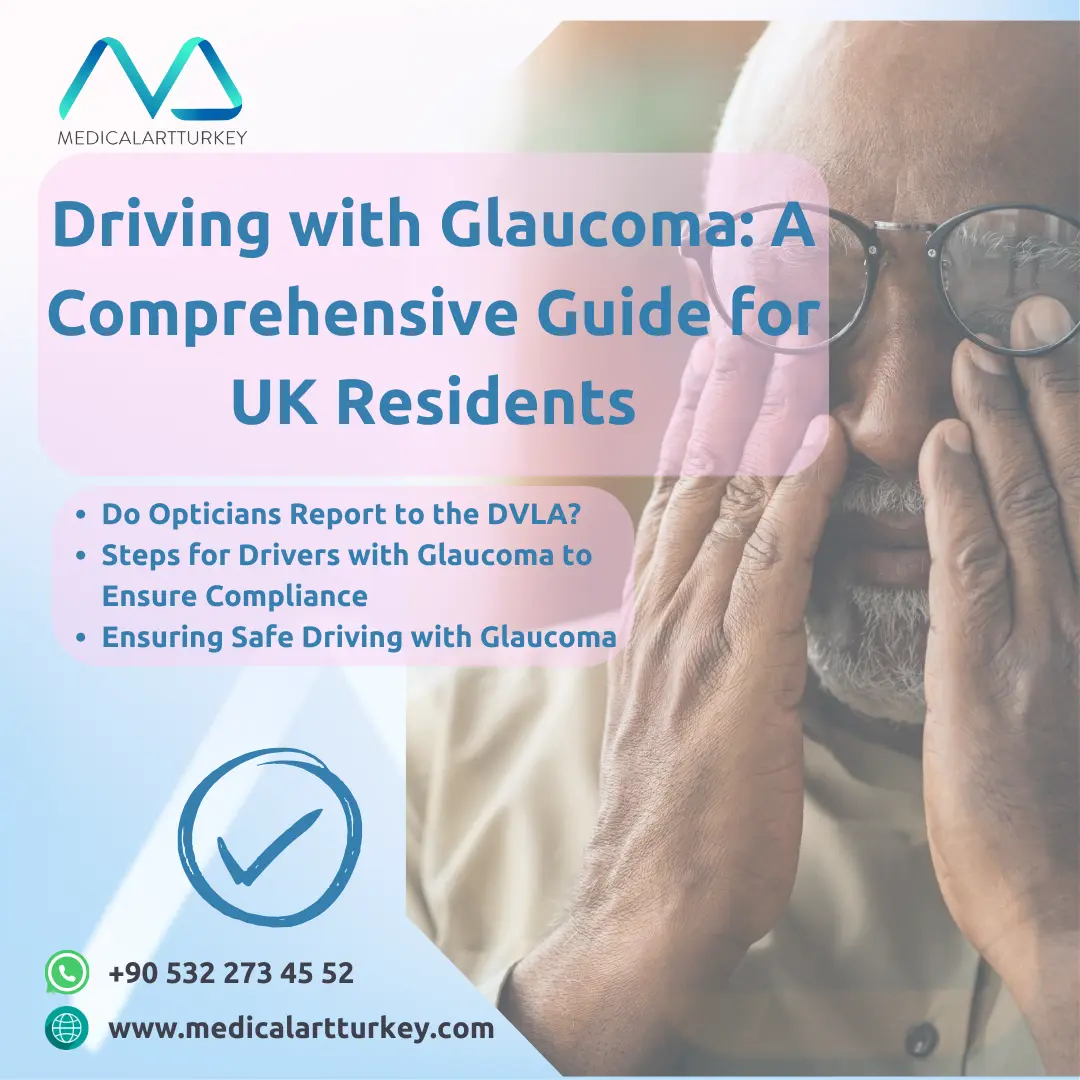Eye Disease Glaucoma
- MedicalArtTurkey

- Sep 2, 2024
- 7 min read
What is Glaucoma?
Glaucoma is one of the most serious and stealthy eye diseases. It occurs when the optic nerve in the eye is damaged, usually due to increased pressure inside the eye (intraocular pressure). The optic nerve is responsible for transmitting visual information from your eye to your brain. If this nerve is damaged, it can lead to vision loss and even blindness.

Symptoms and Types of Glaucoma
Types of Glaucoma
Glaucoma is primarily classified into three types:
Primary Open-Angle Glaucoma:
The most common type of glaucoma.
Develops slowly and usually shows no symptoms initially.
Often discovered during routine eye exams by an optometrist.
If detected early and treated, significant vision loss can be prevented.
Secondary Glaucoma:
Occurs as a result of another eye condition, injury, or as a side effect of certain medications.
Can be triggered by eye injuries, uveitis (eye inflammation), or prolonged steroid use.
Developmental Glaucoma (Glaucoma in Babies and Children):
A rare form that develops at birth or during early childhood.
Caused by genetic factors or developmental abnormalities in the eye.
Symptoms of Glaucoma
Glaucoma is often called the "silent thief of sight" because it doesn’t usually show symptoms in the early stages. However, as the disease progresses, the following symptoms may appear:
Narrowing of the field of vision (tunnel vision)
Eye pain or discomfort
Blurred vision
Seeing halos around lights
Sudden vision loss (in acute glaucoma attacks)
Send us your eye test results, and we will provide a free assessment to determine the most suitable surgery for you!
Intraocular Pressure (IOP) and Normal Values
Intraocular pressure plays a crucial role in the diagnosis of glaucoma. The normal range for eye pressure is typically between 10 and 21 mmHg (millimeters of mercury). The table below shows how intraocular pressure values are classified based on the risk of developing glaucoma:
Intraocular Pressure (IOP) | Risk Status |
10-21 mmHg | Normal (Low Risk) |
22-29 mmHg | Moderate Risk |
30 mmHg and above | High Risk (Glaucoma) |
Send us your eye test results, and we will provide a free assessment to determine the most suitable surgery for you!
Treatment of Glaucoma
The goal of glaucoma treatment is to reduce eye pressure and prevent further damage to the optic nerve. Treatment options include:
Eye Drops: Used to lower intraocular pressure.
Laser Treatment: Helps improve the flow of fluid out of the eye.
Surgery: Considered when medication and laser treatments are not effective.
Driving with Glaucoma
Driving is an essential part of maintaining independence and freedom in daily life. However, to ensure your safety and the safety of others on the road, it's crucial to have good vision. Glaucoma, a common eye disease, can significantly impact your ability to drive safely.
How Glaucoma Affects Vision
Glaucoma primarily damages the peripheral (side) parts of your vision before affecting your central vision. This peripheral vision loss can be subtle and often goes unnoticed in the early stages because you rely on your central vision for most tasks. Moreover, if the damage occurs in different areas of each eye, one eye can compensate for the other, making it even harder to notice any visual impairment.
Risks of Driving with Glaucoma
As glaucoma progresses, the overlapping of damaged areas in both eyes can create blind spots that your brain may fill in, leading to a false sense of complete vision. This compensation can be particularly dangerous while driving, as these unnoticed blind spots might cause you to miss important visual cues, such as other vehicles, pedestrians, or traffic signals, leading to potentially serious accidents.
Example Scenario:
Peripheral Vision Loss: Imagine if your right eye has damage in the left visual field and your left eye has damage in the right visual field. When these damages overlap, you might not notice objects in the center of your vision, posing a significant risk while driving.
Minimum Vision Standards for Driving
In most countries, including the UK, specific vision standards must be met to legally drive. For car or motorcycle license holders, these standards generally include:
Vision Aspect | Minimum Requirement |
Visual Acuity (Central Vision) | At least 0.5 (6/12) on the Snellen scale. |
Peripheral Vision | A field of vision of at least 120 degrees horizontally. |
Monocular Vision (One Eye) | Visual acuity of at least 0.6 (6/10) and a sufficient visual field in the other eye. |
Send us your eye test results, and we will provide a free assessment to determine the most suitable surgery for you!
It's essential to regularly monitor your vision with your eye specialist, especially if you drive. If your vision meets the required standards after treatment, you may continue to drive. However, in some cases, surgery may be necessary to improve vision enough to safely continue driving.
Driving with glaucoma requires careful management of your eye health. Regular eye exams and following your treatment plan are critical to maintaining your ability to drive safely. If you've undergone treatment or surgery for glaucoma, ensure your vision is checked before getting back on the road. This proactive approach can help you retain your independence while ensuring the safety of everyone on the road.
Do I Need to Inform the DVLA?
Glaucoma in One Eye
If you have glaucoma in just one eye, you are only required to inform the DVLA (Driver and Vehicle Licensing Agency) if you hold a commercial (Group 2) driving license. For Group 1 drivers (private car or motorcycle), if glaucoma is present in one eye while the other eye has normal vision, there's no need to notify the DVLA. Similarly, if you have glaucoma in one eye and ocular hypertension in the other, notification is not required.
Glaucoma in Both Eyes
All drivers who have glaucoma in both eyes must inform the DVLA. This is crucial for ensuring both your safety and the safety of others on the road.
Monocular Vision (Sight in One Eye Only)
If you have vision in only one eye, you must meet the same visual acuity and visual field test standards as someone with vision in both eyes. In cases of total vision loss in one eye (meaning you cannot perceive light at all), you must notify the DVLA. You will only be allowed to continue driving after a clinical advisor confirms that you meet the necessary safety standards.
Send us your eye test results, and we will provide a free assessment to determine the most suitable surgery for you!
DVLA Testing Requirements
When you inform the DVLA about your condition, they may request additional details about your vision and arrange for a vision test at an approved center, such as Specsavers in the UK. The tests that assess your ability to drive safely include:
Visual Acuity Test: This measures how well you can see details at a distance. You must achieve a visual acuity of at least 6/12 (meaning you can see at 6 meters what a person with normal vision can see at 12 meters) and be able to read a standard car number plate from 20 meters.
Visual Field Test: This evaluates your peripheral (side) vision, which is critical for detecting hazards while driving. You should have a horizontal field of vision of at least 120 degrees, with no significant defects within 20 degrees of the center.
Your test results will be sent to the DVLA, who will decide if you meet the required standards. You're entitled to a copy of your visual field test results at the time of your appointment. If the test center cannot provide one, you can request a copy from the DVLA.
The DVLA can only make a decision based on accurate visual field charts. You can take up to three visual field tests at your appointment if the first or second charts do not meet accuracy standards. Depending on your field of vision, the DVLA may issue a restricted driving license valid for one, two, three, or five years.
Right to Appeal
Informal Appeal
If you receive a letter from the DVLA stating that your driving license is being withheld (not re-issued) or revoked (taken away), the letter will include information about your right to appeal and guidance on the process.
If your visual field test does not meet the required standard, you can seek a second opinion from an independent optometrist and have another visual field test, which you will need to pay for (the initial test is funded by the DVLA). The DVLA will consider the best result among the tests.
If the independent optometrist’s test suggests that your vision might meet the required standard, the DVLA will allow you to re-apply and will send you for a further test at an approved optician (e.g., Specsavers). If you have any additional medical information that was not available at the time of the initial decision, you can submit this new information. A dedicated team at the DVLA will review it promptly.
Send additional information to: DM Business Support, D7, DVLA, SA99 1ZZ. Make sure to include the DVLA reference number at the top of the letter.
Send us your eye test results, and we will provide a free assessment to determine the most suitable surgery for you!
Formal Appeal
You also have the option to make a formal appeal to the Magistrates’ Court of England or Wales, or a Sheriff Court in Scotland. The time limits for appeals vary:
England and Wales: The appeal must be lodged within six months of the revocation decision.
Scotland: The appeal must be brought within three weeks of the decision being made.
Drivers in Scotland should use the correct postal address and send the information promptly to: DM Business Support, D7, DVLA, SA99 1ZZ. A specialized team will prioritize these cases and respond immediately.
Before deciding to make a formal appeal, you may wish to consult with your eye specialist or GP to confirm whether you have a valid case, as losing the appeal may result in additional costs.
Your Responsibilities
Driving Insurance
You must inform your insurance company about your glaucoma in each eye. Failure to do so may invalidate your insurance. If the DVLA permits you to continue driving, your insurance company should not refuse coverage, and your premium should not be affected.
General Responsibilities
As a driver, it is your legal duty to inform the DVLA of any medical condition that may impact your ability to drive. Additionally, the medical profession has a responsibility to notify the DVLA if they are aware that someone who may not meet the required standards continues to drive.





















Comments